class MyClass {
var someProperty = 0
deinit {
// never gets called
}
func doSomething() {
DispatchQueue.global().async { [weak self] in
Thread.sleep(forTimeInterval: 3600)
self?.someProperty = 123
}
}
}
class MyViewController: UIViewController {
var myClass: MyClass?
deinit {
// MyViewController gets properly deallocated
}
override func viewDidLoad() {
super.viewDidLoad()
myClass = MyClass()
myClass?.doSomething()
}
}
When running the above code, MyClass never gets deallocated even when MyViewController is popped of the navigation stack or gets dismissed.
However, if I move the implementation of MyClass directly to MyViewController, everything works as expected:
class MyViewController: UIViewController {
var someProperty = 0
deinit {
// MyViewController still gets properly deallocated
}
override func viewDidLoad() {
super.viewDidLoad()
DispatchQueue.global().async { [weak self] in
Thread.sleep(forTimeInterval: 3600)
self?.someProperty = 123
}
}
}
I used the Debug Memory Graph to figure out what is still keeping a reference to the instance of MyClass and this is what I get:
Why is there still a reference? What am I missing here?
UPDATE
So I was trying to figure out why it works with MyViewController but not when having another instance in between. Seems like inheriting from NSObject makes a difference. When I inherit MyClass from NSObject, deinit is called and once the long operation is finished, self is then correctly set to nil.
The question now is, in what way are capture lists in Swift related to NSObject?
